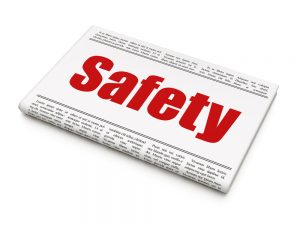May & June 2021


Every minute counts in an emergency.
The outcome of workplace illnesses and injuries depends on the severity of the injury, available first aid care, and medical treatment. Prompt, properly administered first aid may mean the difference between rapid or prolonged recovery, temporary or permanent disability, and even life or death. OSHA’s medical services and first aid standard at 1910.151 requires that in the
absence of an infirmary, clinic, or hospital in near proximity to the workplace, employers have a person or persons adequately trained to render first aid. Adequate first aid supplies must be readily available. Anyone who has been designated by the employer to provide first aid must have thorough training on how to respond to the injuries and illnesses anticipated in the workplace. Employees who are not designated first aiders should know how to promptly report injuries and illnesses. Obtaining and evaluating information about the injuries, illnesses, and fatalities at a worksite are essential first steps in planning a first aid program. Employers can use the OSHA 300 log, OSHA 301 forms, their workers’ compensation insurance carrier reports, or other records to help identify the first aid needs for their businesses.
First aid involves so much more than a bandage…
Minutes count when someone is injured or becomes ill on the job. Employers can keep the situation from getting worse by providing the right type of first aid treatment right away.
Overview
Anyone who has been designated by the employer to provide first aid must have thorough training on how to respond to the injuries and illnesses anticipated in the workplace. Employees who are not designated first aiders should know how to promptly report injuries and illnesses. This training outline can be used as a general introduction to first aid programs.
Specific training elements
1. Introduce OSHA’s expectations for first aid programs. Where an accident can result in suffocation, severe bleeding, or other life threatening or permanently disabling injury or illness, OSHA expects a three to four minute response time from the time of injury to the time of administering first aid. If such a life threatening or serious injury is unlikely, OSHA allows a longer response time, such as 15 minutes. To ensure treatment is available within these timeframes, OSHA requires the employer to train persons to render first aid when there’s no nearby hospital, clinic, or infirmary that’s used to treat all injured or ill employees. First aid providers perform the initial assessment of injuries and illnesses and provide immediate care and life support before emergency medical services (EMS) professionals arrive.
2. Display your first aid supplies. First aid supplies must be readily available in an emergency. There must be appropriate supplies (in adequate amounts) for the types of injuries and illnesses that are likely to occur based on an understanding of the activities in the workplace. OSHA says that medical personnel must be available to consult with the employer on matters of plant health. Employers can work with medical professionals who treat injured employees to get help in determining what supplies should be in the facility’s first aid kits and how many kits are needed. As guidance, employers can consult American National Standards Institute ANSI Z308.1, Minimum Requirements for Workplace First Aid Kits. It describes two classes of basic kits. Class A kits are intended to provide a basic range of products to deal with most common types of injuries encountered in the workplace, such as major wounds, minor wounds (such as cuts and abrasions), minor burns, and eye injuries. Class B kits are intended to provide broader range and quantity of supplies to deal with injuries employees may encounter in more populated, complex, and/or high risk work environments.
3. Emphasize the importance of first aiders taking “universal precautions” to prevent exposure to bloodborne pathogens. Blood can carry microorganisms such as hepatitis B virus (HBV) and human immunodeficiency virus (HIV) that can cause serious diseases. OSHA’s bloodborne pathogens standard, 1910.1030, applies to all employees with “occupational exposure” to blood or other potentially infectious materials (OPIMs). Employees who are expected to provide first aid as part of their job duties are covered by the standard. When a first aid response involves exposure to blood and OPIMs, first aiders must use “universal precautions.” This is an approach to infection control where all human blood and certain body fluids are treated as if they were known to be infectious for bloodborne pathogens. Wearing rubber exam gloves and protective clothing is part of following universal precautions.
4. Explain how first aid providers start by assessing the situation. When first aid providers arrive at an accident scene, they first evaluate what happened, how many people are injured, and whether it’s safe to enter the area. In serious situations, they’ll make sure emergency medical services (EMS) professionals are on the way. First aiders have to ensure their own safety before they can help the injured. They’ll consider everyone’s safety when they decide on making rescues and moving victims. They’ll assess the injuries of each victim and check for responsiveness, breathing, and circulation. They’ll also look for any medical alert tags a victim might be wearing.
5. Outline first aid response to life threatening emergencies. Life threatening medical emergencies can involve conditions such as:
• Chest pain,
• Stroke,
• Breathing problems,
• Allergic reactions,
• Seizures, and
• Severe bleeding.
If an injury is life threatening, first aid providers are trained to:
• Perform CPR (cardiopulmonary resuscitation), and use an automated external defibrillator (AED)
• Recognize the signs and symptoms of shock and provide treatment
• Control bleeding with direct pressure
• Provide other treatment to stabilize the victim
6. Discuss AED programs. OSHA’s Best Practices Guide: Fundamentals of a Workplace First Aid Program says that an AED should be considered when selecting first aid supplies. AEDs provide the critical and necessary treatment for sudden cardiac arrest (SCA) caused by ventricular fibrillation. Ventricular fibrillation is the uncoordinated beating of the heart leading to collapse and death. An electric shock delivered by an AED can restore the heart to a normal rhythm. Using an AED within three to four minutes after the victim has suffered SCA significantly improves the survival rate. CPR should be administered until the AED unit is brought to the victim. This basic form of life support uses chest compressions and artificial respiration.
7. Outline some non life threatening emergencies encountered by first aid providers. First aid providers know how to provide initial treatment for conditions such as:
• Cuts, abrasions, puncture wounds, crushing injuries, and other wounds
• Burns
• Temperature related conditions including frostbite, hypothermia, and heat stroke
• Sprains and strains
• Eye injuries
Even though these conditions may not be life threatening, the victim may still need medical treatment beyond first aid.
8. Summarize your program. Every employee needs to know how to report a medical emergency. A quick response is necessary when there is an injury or sudden illness. However, the response needs to be made by personnel who have proper training.
